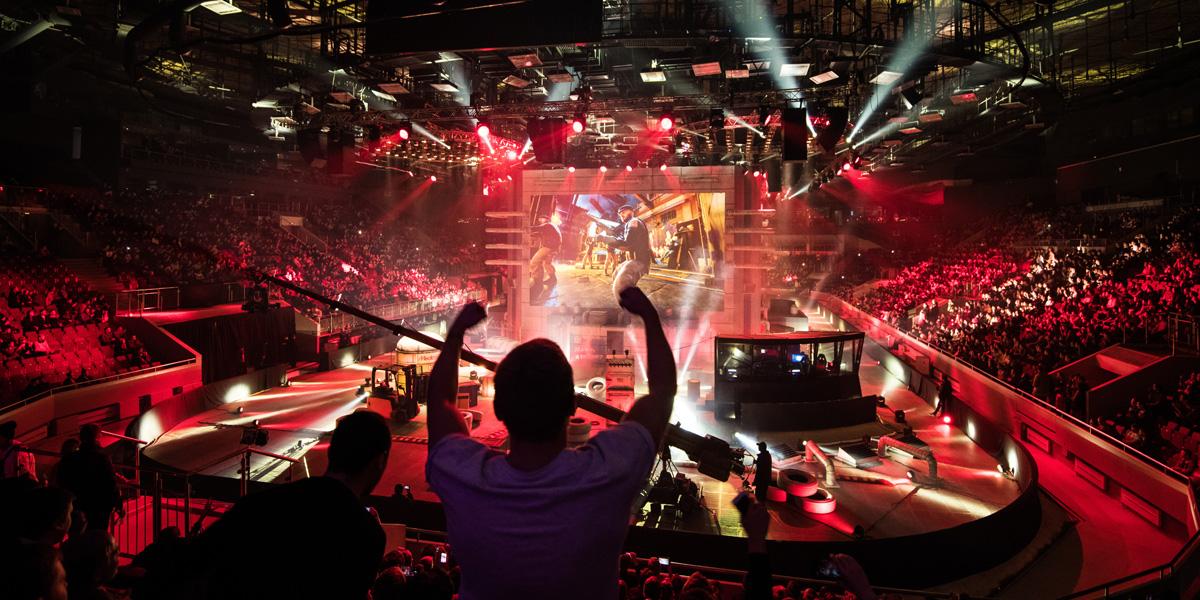The Growing Esports Market and the Impact of 5G
Esports is receiving great attention all around the world. This form of competition carried out through computer games, video games, and smartphone games is considered a sport and is evolving and growing worldwide. Let’s dive into everything from the size of the global esports market to the circumstances of esports in different countries, as well as the network environments such as 5G networks that are enhancing the rising popularity of esports. We’ll take a look at the present and future of esports.
INDEX
1. The spread of esports, surpassing the boundaries of country or culture
2. Overview of the global esports market size and the circumstances of esports in each country
3. The impact of network environments and 5G on esports
1. The spread of esports, surpassing the boundaries of country or culture
Are you familiar with a LAN party? Or perhaps you actually participated in one, but are not aware of the phrase? A LAN party is a “party” where a number of people bring their computers and monitors to a friend or acquaintance’s home, where they connect to a LAN (Local Area Network) to play a competitive game. These LAN parties, which are thought to have first began in the United States in the 1990s when the use of personal computers and the Internet became more common, really influenced the development of esports.
“Esports” stands for “electronic sports.” These LAN parties, which were more casual gatherings, eventually evolved into large-scale events with large audiences. These events are transforming into a style of competition connecting players from around the world via the Internet and viewed by tens of millions of viewers who are watching them compete. It is not uncommon for large tournaments to be funded by a number of corporate sponsors, with hefty prizes for the winners.
In the 2018 time frame, news about esports being added as an official Olympic sport instantly spread the word about esports. While it remains controversial as to whether video games can be considered a sport, esports is expanding worldwide, proving itself to be a diverse sport where proficiency does not hinge on a player’s physical characteristics, gender, or whether or not they have a disability. In the United States, esports players are considered athletes, and there are even states where esports is a high school sport. The reflexes and cognitive skills required for esports are drawing attention across countries, cultures, and disciplines, and there are high hopes of its application in medicine and welfare in areas such as rehabilitation.

2. Overview of the global esports market size and the circumstances of esports in each country
The esports market grew by $900 million (about 90 billion yen) globally in 2018 and is expected to grow to $1.6 billion (about 160 billion yen) by 2021. [The following is as reported by *Newzoo.] Most of esports revenue comes from sponsorship fees, advertising, broadcasting rights, ticket sales, and merchandise sales. If we look at each country and region, we can see that the North American markets (U.S. and Canada) take the lead, accounting for nearly 40% of the global revenue. This is followed by China, South Korea, and other Asian countries. Let’s take a look at how esports are doing in each country.
*This linked page is in Japanese.
North America, where there is a focus on the expansion of professional gamers
Known as the biggest esports powerhouse in the world, the United States does esports on a completely different scale, both physically and monetarily. For instance, the total prize money for a popular game’s world competition held in 2019 was $30 million (about 3 billion yen). Forty million players participated from all over the world. When a 16-year-old American took home the $3 million first place prize, it created a great sensation. In another case, the finals of a different popular game competition was estimated to have been viewed by 40,000 live spectators and about 27 million live streaming viewers.
This kind of attention results in part from the work of the world’s largest professional esports association, established in 2002, which actively hosts and streams competitions, contributing to the popularization of esports. In 2013, the United States government issued pro-athlete visas to gamers, and esports classes and scholarships are even being offered at universities, high schools, and other educational institutions. The major live-streaming platforms are run by American mega IT corporations, which are expected to continue to take the lead in the market.
China - Experiencing rapid growth in mobile esports
China makes up 18% of the global esports market, coming in after the United States. It is worth noting that the number of people taking part in esports is 250 million, making up more than 60% of the esports participants in the world (estimate). This may be due to the success of professional gamers in international competitions and the advanced infrastructures such as esports clubs and streaming websites centered in Shanghai, which is aiming to become the esports capital of the world. Another characteristic of the esports market in China is the large number of people using mobile devices (smartphones, etc.), which are more readily accessible to many than computers, boosting the popularity of mobile device esports.
South Korea, esports rapid progress through government support
Though the United States is the esports powerhouse of the world, South Korea is known as the country where the esports market first came into fruition. A government-approved Korea e-Sports Association was established and a registration system for professional gamers began as early as the year 2000. They were already holding an international esports competition the following year. Since then, the South Korean esports market has grown to make up about 6% of the global esports market. In 2018, a facility built under South Korea’s Ministry of Culture, Sports and Tourism displaying esports history in South Korea opened. Not only is South Korea the first country where the esports market really fully developed, they also have a secure position as an esports mecca.
Japan a rapidly growing but still premature esports market
The esports market in Japan was worth approximately 5 billion yen in 2018 and is expected to exceed 8.5 billion yen by 2021. Despite this, Japan’s esports market makes up less than 1% of the global market and is still under development. This is because in Japan, esports face obstacles such as the possibility that high winnings could violate the Act Against Unjustifiable Premiums and Misleading Representations as well as gambling laws. Legal changes and other measures will need to be taken before esports can really take off.
Meanwhile, the popularity of esports is rising and infrastructure development is speeding up, as seen at the National Sports Festival, the first esports championship in Japan’s history, held in Ibaraki Prefecture in October 2019. Esports-centered facilities are opening up one after the other in areas like Tokyo, Osaka, and Nagoya.
If we were to try to look into the future of esports, we cannot leave out the topic of changes to lifestyle and attitudes from the COVID-19 pandemic. While events were getting canceled one after the other, the increase in the time people spent at home led to a burst in sales of game consoles and games. The circumstances also sparked a surge in online live streaming. As a sport that you can play without ever coming face to face with your opponent, esports is expected to increase its presence in the post-COVID world, as we all continue living in this “new normal” where there are measures like social distancing in place.

3. The impact of network environments and 5G on esports
Competitions are taking place involving players located far away from one another, and millions of people all over the world tune in to watch. With all of these people brought together through connections to the Internet, network environments become a crucial point in the world of esports. In fact, it is not uncommon to temporarily stop a tournament because of lags in gameplay and streaming due to an unstable internet connection.
The technology that is expected to put an end to these problems and provide an even bigger boost to the spread of esports is 5G, 5th generation mobile communications system technology. 5G technology offers high speed and high throughput, low latency connections, along with the ability to handle massive numbers of connections, which means that using it will allow a large number of players to play at the same time without the stress and device issues that come with using LAN, etc. It is also expected to propel the spread of “cloud gaming,” in which games are processed on a cloud platform and streamed to mobile and gaming devices.
With its superiority in terms of the total amount of data that can be exchanged per second (bps), 5G will be a great advantage to broadcasting and streaming platforms that handle large amounts of data at a time. For players, the most important benefit comes in the form of reduced lag. During a heated, tight competition, the amount of lag from when a command is input and when the command is carried out can be the difference between a championship victory or a sudden loss.The ping value, which is the speed between data transmission and response, is what decides whether you get low latency. 5G also offers superior ping values, with technology that is designed to reduce latency during gameplay and delivering high throughput during streaming (network slicing).
Once 5G technology is able to pervade everything from the players’ devices to the network providers, platform providers, and other servers, it is set to make things a lot easier for those in the world of esports, and even make AR and VR more accessible. There is no doubt that 5G will become an enormous push for the popularization of esports in Japan as well, with major telecom companies and other corporations using 5G as an opportunity to enter the esports market one after the other. Given the development in network environments and the expansion of the global esports market, all in addition to the new-normal society, it is safe to say that esports demonstrates extremely high potential.


